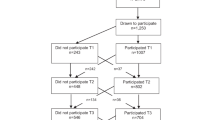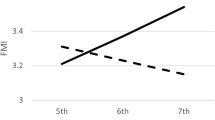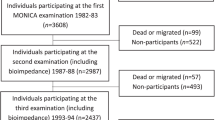Abstract
OBJECTIVE: To investigate if there is a longitudinal relationship between the development of fat mass in males and females (aged between 12–28 y) and their lifestyle, with respect to diet and physical activity.
DESIGN: In the Amsterdam Growth And Health Longitudinal Study (AGAHLS), a group of 500 boys and girls are being followed from the age of 13 y (mean age 13.5 y), over a period of 20 y until the age of 32 y (mean age 32.5 y).
SUBJECTS AND MEASUREMENTS: Data from AGAHLS are analysed of six repeated measurements of growth (body height, body mass, four skinfolds), health parameters with respect to cardiovascular disease (CVD) (obesity, hypertension, hypercholesterolaemia) and two important lifestyle tractors: physical activity (PA) (weighted energy output) and dietary intake (DI) (total energy intake, contribution of fat, carbohydrate and protein) of about 200 males and females between the ages of 13–27 y.
RESULTS: The longitudinal results of PA show a steep decrease in the energy expenditure from the age of 13 y from about 4500 Mets per week to 3000 Mets per week at the age of 27 y in both sexes. The longitudinal results of DI also show a decrease in energy intake per kilogram body mass from about 225 kJ per day at the age of 13 y to about 155 kJ at the age of 27 y. During adolescence, boys show a 15% higher energy intake and a 20% higher energy expenditure than girls. At the age of 27 y, the difference between the sexes in energy intake is reduced to 10% and the difference in energy expenditure disappears. Results of tracking analyses over the period of 15 y indicate a low stability coefficient of PA (0.34; 0.19–0.49), but higher coefficients of DI (0.55; 0.45–0.64) and fat mass (0.63; 0.56–0.71). The search for important lifestyle factors that can discriminate high- from low-risk participants for a high fat mass, estimated from the sum of four skinfolds and body mass (BM), resulted in an Odds Ratio (OR) of 1.5 (1.2–1.8) with daily intake of proteins and an OR of 0.81 (0.69–0.96) with PA. Surprisingly the fat mass is negatively related with the daily intake of energy per kg BM (OR: 0.37; 0.28–0.49). The longitudinal relation between fat mass and PA (corrected for DI) between the ages of 13–27 y, showed a significant inverse relationship (P<0.01) if fat mass was estimated from the sum of four skinfolds, but not if estimated from the body mass index (BMI).
CONCLUSIONS: Over the adolescent and young adult period from 13–27 y, fat mass indicates a fairly good predictability. A high PA in both sexes is related with a low fat mass. Therefore promotion of habitual physical activity in the adolescent period seems effective in the early prevention of obesity.
This is a preview of subscription content, access via your institution
Access options
Subscribe to this journal
Receive 12 print issues and online access
$259.00 per year
only $21.58 per issue
Buy this article
- Purchase on Springer Link
- Instant access to full article PDF
Prices may be subject to local taxes which are calculated during checkout
Similar content being viewed by others
Author information
Authors and Affiliations
Rights and permissions
About this article
Cite this article
Kemper, H., Post, G., Twisk, J. et al. Lifestyle and obesity in adolescence and young adulthood: results from the Amsterdam Growth And Health Longitudinal Study (AGAHLS). Int J Obes 23 (Suppl 3), S34–S40 (1999). https://doi.org/10.1038/sj.ijo.0800881
Published:
Issue Date:
DOI: https://doi.org/10.1038/sj.ijo.0800881
Keywords
This article is cited by
-
Effects of Movement Behaviors on Overall Health and Appetite Control: Current Evidence and Perspectives in Children and Adolescents
Current Obesity Reports (2022)
-
Family, school and individual characteristics associated with adolescents’ physical activity at school in Hong Kong: the iHealt(H) study
International Journal of Behavioral Nutrition and Physical Activity (2021)
-
Postprandial glycemic response differed by early life nutritional exposure in a longitudinal cohort: a single- and multi-biomarker approach
European Journal of Nutrition (2021)
-
Modeling the dynamics of BMI changes during adolescence. The Oporto Growth, Health and Performance Study
International Journal of Obesity (2015)
-
Associations between smoking, components of metabolic syndrome and lipoprotein particle size
BMC Medicine (2013)



